"J'ai toujours aimé l'architecture. Plus que tout" reflected Eileen Gray in 1973, 'I've always loved architecture. More than anything", continuing, 'but I didn't think I was capable of it'.1
A capability her first major project, the villa E.1027 at Roquebrune-Cap-Martin on France's Côte d’Azur, tended and tends to underscore she needn't have doubted. If a capability that over the decades has oft been as concealed and inaccessible as E.1027.
With the film E.1027 – Eileen Gray and the House by the Sea writers and directors Beatrice Minger and Christoph Schaub explore not just the biography of E.1027, but architecture as more than just construction, and also relationships with and within architecture, and in doing so allow not only for differentiated reflections on the (hi)story of architecture, but also enable one to better locate Eileen Gray, and her House by the Sea, in that (hi)story, and thus to better locate Eileen Gray not only as the architect she doubted she could be, but as a more instructive and informative architect than she is often appreciated as.......
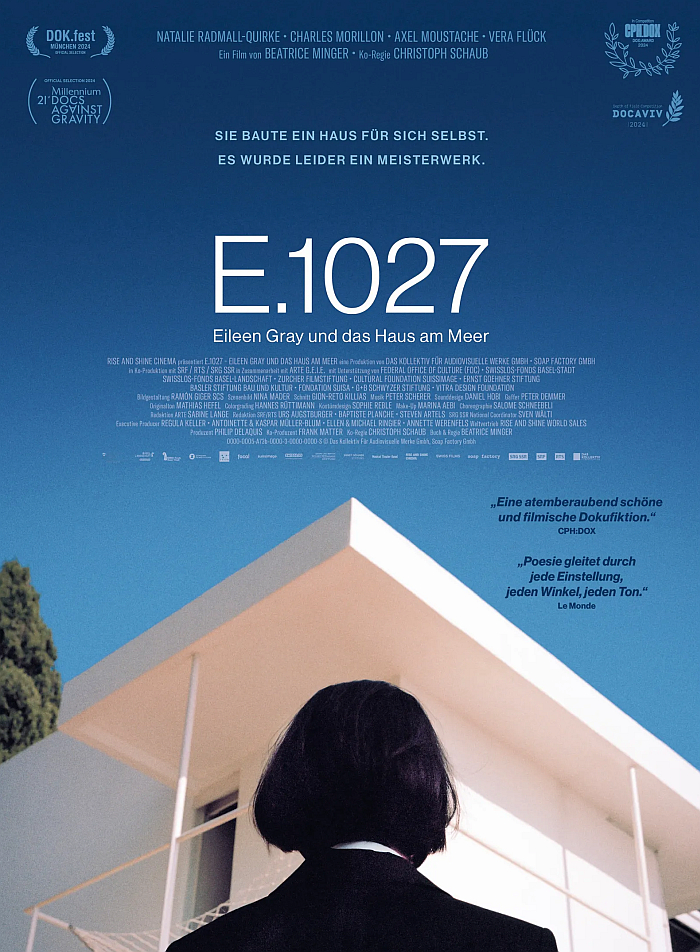
Albeit a film that was almost a eulogy.
Until 2006 E.1027 was a dilapidated ruin on the rocks above the Mediterranean, a villa that once stood at one with the sea threatened to crumble into it, lost forever, until a combination of public and private initiatives collaborated on a long, at times fraught, process of repair, restoration, rescue and rediscovery.
A fall into disrepair that was as much biographical as it was physical: the material deterioration of E.1027 over the decades also resulted in an immaterial deterioration, a loss over time of information on the genesis of the work, its author, its raison d'etre, it's didactic. A fall into disrepair that was also a fall into silence.
A fall into disrepair that was as long as it was complicated2 and in many regards begins with the death in 1956 of Jean Badovici, a native Romanian who had travelled from Bucharest to Paris in 1915 to study architecture, graduating in 1919 from l'École Spéciale d'Architecture, and in 1923 becoming the founding editor of L'Architecture vivante, one of the more influential magazines devoted to avant-garde architectural approaches and position in the 1920s, and a Jean Badovici who had been the villa's primary resident since the early 1930s, and to whom the villa formally belonged.
But a villa, une Maison en bord de mer, a house by the sea, that had been built by and, in all other respects apart from the formal legal paperwork, belonged very much to Eileen Gray; an Irish born creative who has featured regularly in these dispatches, and for whose (brief) biography we refer you to a previous post, save to note here that in 1921 Eileen Gray was introduced to Jean Badovici, who in turn suggested Gray move from the art, craft, applied art, furniture design and interior design she had until then practised to the architecture that was such a great passion.
"D'abord, je lui ai ri au nez", she recalled many years later, 'At first, I laughed in his face'.3 And that, one presumes, on account of her aforementioned self doubt. But, arguably, because her personality meant she could do no less, and because, "J'ai toujours aimé l'architecture", she made that move, helped by Badovici's experience, by conversations with Badovici, by trips with Badovici to contemporary architectural projects in France, Germany and Holland4, and physically helped by Badovici via his contribution to the facade of her studio and shop space Jean Désert, a business that opened in 1922 on rue du Faubourg-Saint-Honoré in the heart of Paris's 8. Arrondissement; a 'Jean' chosen because Gray felt a male creative would have a better chance than a female in 1920s Paris, and a 'Désert' chosen to evoke the sands of North Africa, a place Gray had developed a fondness for, and enjoyed some extreme experiences in, over the years. And a name 'Jean Désert' that may or may not have been an omen of things to come.
In 1926 Gray and Badovici developed their first large scale architectural project with the renovation of a number of houses in the village of Vézelay in the Bourgogne, whereby Tim Benton argues Gray's contribution was, at best, minimal5; which may or may nor be related to the fact that at the same time work was beginning on a project of much greater importance, significance, to and for Eileen Gray: E.1027. A villa developed and constructed between 1926 and 1929, a villa designed and financed by Gray, to which Badovici contributed technical aspects, including the from him patented vertical folding windows6 that allow interior and exterior to communicate so effortlessly. And a E.10277 Eileen Gray and Jean Badovici shared, before in 1932 Gray left. The relationship and E.1027.
"Now, I'm going back" her character announces at the start of E.1027 – Eileen Gray and the House by the Sea.
Back in the company of film-makers, actors, and the most recent research and analysis on and of E.1027.
And with the most recent research and analysis on and of the frescos on the walls of E.1027
Frescos not by Eileen Gray nor by Jean Badovici but by Le Corbusier.
Frescos that weren't planned for E.1027, weren't a component of E.1027's conception and intention, but frescos that were for a great many years the focus of attention when viewing E.1027.
And frescos that were the genesis of the idea that led Beatrice Minger and Christoph Schaub to write and produce E.1027 – Eileen Gray and the House by the Sea.
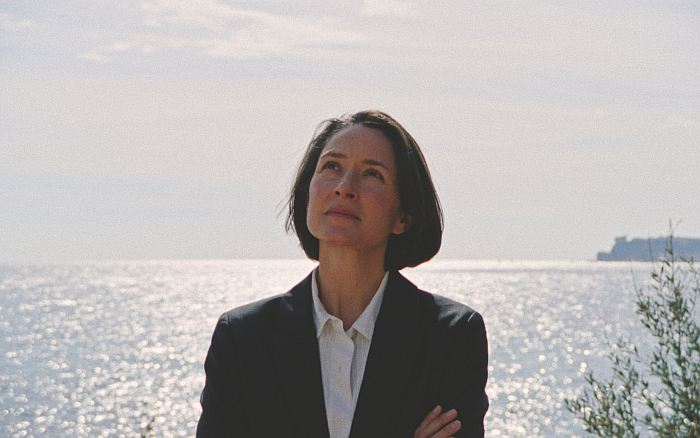
A film in which Eileen Gray, Jean Badovici and Le Corbusier exist in dialogue with one another, directly and indirectly, on architecture, design, space, the human condition, dialogues that while following and engaging with it is important to remember that in E.1027 "narration and dialogues are based on and inspired by original texts and quotations", it's not all direct quotes, there is a lot of summarising the words and arguments of all three protagonists, placing words in their mouths they never said, which doesn't detract, but which you should always remember; a film in which Gray, Badovici and Le Corbusier exist both within and around E.1027 and also on a theatrical stage setting, a single set which simultaneously serves as a variety of locations, and thus tends to reinforce that E.1027 is more a piece of theatre than a film. And a stage setting and "inspired" staged dialogues that underscore E.1027 as a hybrid docu-fiction production.
A film that opens with the setting of Eileen Gray in post 1914-1918 War Paris; the setting of Eileen Gray in a post-War Paris in which a myriad avant-gardes were taking their faltering first steps; the setting of Eileen Gray in the sexual freedom and liberation of post-War Paris; the setting of Eileen Gray in the gender discourses of post-War Paris; the setting of Eileen Gray in the sexual and gender battles of post-War Paris; the setting of Eileen Gray as a woman of independent means thanks to her family's wealth, a women with the £500 a year and a room of one's own a Virginia Woolf wished all females had access to in the 1920s; the setting of Eileen Gray's work in a moment of movement from the lacquer objects and furniture of her earliest years to room settings, of an increase in the scale and spatial complexity in her work, of an increased communicativeness and polemic of her work.
And a setting of Eileen Gray in post-War Paris to which Jean Badovici enters, specifically in context of Gray's 1923 Boudoir de Monte Carlo, a room installation by Gray presented in context of the Salon des Artistes Décorateurs. A chronologically incorrect arrival of Badovici in the Gray narrative, he was already there, but an entry at a highly relevant moment in Gray's career, a moment whose relevance almost empowers Minger and Schaub to take liberties with chronologies: the Boudoir de Monte Carlo being, in many regards, Gray's breakthrough installation. A work that garnered a lot media coverage8: a lot of negative coverage, whose avant-garde positions did not go down well with the, one imagines more conservative inclined, Parisian criterati of the day, but also a lot of positive coverage, including in L'Architecture vivante, where, amongst other positive, occasionally borderline hyperbolic, comments, Badovici describes the Boudoir as a work in which 'a strong, if somewhat restless, personality, animates the austerity of geometric constructions', that 'for Eileen Gray, space is nothing more than a plastic material that can be transformed and shaped according to the requirements of decoration and which offers the artist infinite possibilities' ending with the opinion that "l'art ne veut que traduire dans la matière la volonté humaine", 'art only wants to translate human will into matter'.9
An 'art' of Eileen Gray, a desire on Gray's part to translate immaterial human will into the material human world, Badovici located in a 1924 article for the Dutch architecture magazine Wendingen 'at the heart of the Modern movement', continuing 'Eileen Gray is Modern in all her tendencies, in all her characteristics of her vision and her expression, in her disdain for the emotions in which the old aesthetics delighted, in her contempt for the old plastic forms' and that 'she understood that our time brought with it new forms of life, the need for new ways of feeling'.10
And while, yes, he would be full of praise given the nature of the personal and professional relationship, with E.1027 Eileen Gray created a (further) argument to the validity of those opinions.
And an argument for the validity, necessity, relevance, of her move from interiors to architecture.
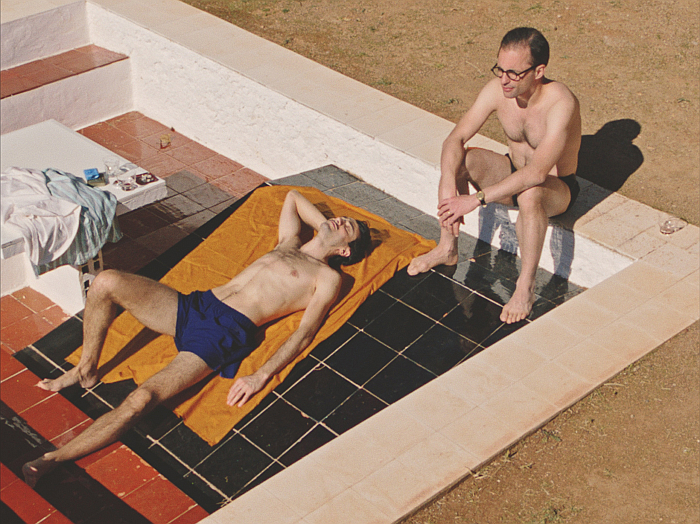
The novels of Émile Zola's Rougon-Macquart cycle with its examinations of nature versus nurture and its critical study of the social, economic, political and moral realities in Second Republic France, tend to be positive and happy and buoyant until the middle, then things take a turn for the worse and its downhill till the end.
In E.1027 the good times only last for the first third.
The depiction of the breakdown of Eileen and Jean's relationship in E.1027, the transition from the good times in the first third to the trials of the second two thirds, being a particularly satisfying piece of theatre; a scene that in a neat contrast to the other theatrical pieces plays out in situ in E.1027 not on the stage, thereby augmenting its agency. A scene that, in many regards, echos Zola in its use of continuation of imagery, with a subtle shift in the symbolism, to link the good times with the bad, to highlight the changes occurring: that which was once a symbol of happiness and a future to be approached boldly, is now a symbol of malaise and a future derailed.
And as the scene in E.1027 progresses, Jean désert(e). And Eileen désert(e).
Or more accurately Jean leaves the relationship but remains in E.1027, while Eileen leaves both, basing herself in a second house, Tempe a Pailla, she had constructed in the hills near the town of Castellar, just some 10 kilometres from E.1027. A house in which she found the solitude she needed; for all her outward avant-garde ease and her apparent self-confidence as an independent female creative in a France struggling to emancipate itself from its patriarchy, she was incredibly, shy, introvert by nature, "je suis horriblement timide"11, as she opined in 1973. Probably wouldn't have liked the idea of a film being made about her; but also, one gets the impression, wouldn't have objected that it was made.
A separation which in E.1027 isn't total: Jean's character bewailing at length the loss of Eileen; while Eileen's character reflects, while sat at her draughting table in Tempe a Pailla, "sometimes I wondered what the men were doing in the house ... Bado getting up to who knows what with Legér and Le Corbusier".
A slightly chunky, clunky, segue to that which was the major motivation of E.1027 but which don't make an appearance until the 52 minute: the frescos. Or more accurately in the 52 minute the subject of E.1027 changes from E.1027, Gray, Badovici and Le Corbusier, to the frescos.
If 52 minutes before the arrival of frescos Minger and Schaub diligently use to lay numerous paths to the significance, symbolism, context and controversy of the frescos on the walls of E.1027.
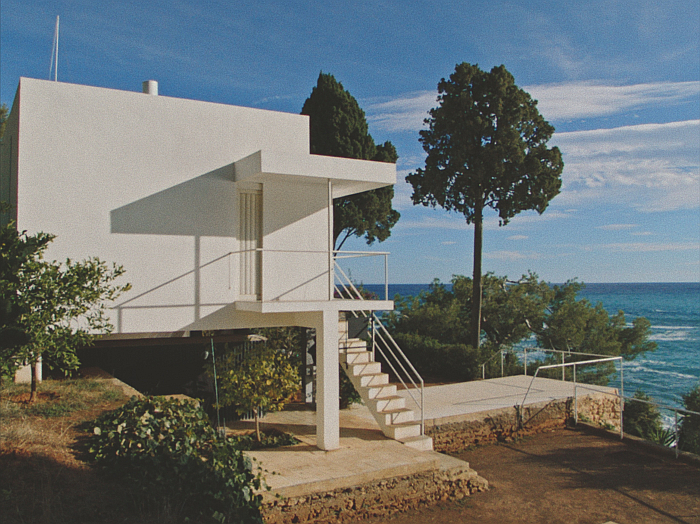
Paths that aside from elucidating the personal importance of E.1027 to Eileen Gray, as a private space for her and Badovici but also a refuge for her shy, introvert, self, and aside from helping you locate E.1027 in context of a challenging by Gray of conventional appreciations of females and the roles of females in early 20th century France, also help explain E.1027 as a reflection of Eileen Gray's positions on and to architecture, whereby a key moment in the film is when Gray's character asks "C'est quoi une maison?", 'What is a house?' "C'est quoi son essence?", 'What is its essence?' and then in a very nice, very simple but very effective, piece of theatre Gray and Le Corbusier's characters engage in a discussion with one another on the 'essence' of architecture, on the demands of architecture, on relationships with and within the built environment, on 'what is a house', and all without engaging directly with one another.
Paths laid in the first 52 minutes that thus help lead one to the core of what E.1027 is and was for Eileen Gray: her interpretation of Functionalist Modernism, her interpretation of Functionalism and of Modernism, her response to the, for her, problems and shortcomings of Functionalist Modernism in the 1920s, her demands for an architecture that was more humane, less mechanical, more responsive, less formulaic, that started with the user not with theory, where function was more emotional than technical; E.1027 as, one can argue, certainly E.1027 builds an argument in that direction, a direct challenge to the positions and approaches of a Le Corbusier.
And also a female interpretation of Functionalist Modernism, an architecture for women. An architecture that until then barely existed: over centuries architecture was male, not just in terms of the education, practice, fame and affluence of architecture but the results of architecture were male, buildings were designed by men for men, designed by men for a patriarchal society, designed by men as components of facilitating and supporting a patriarchal society. And in many regards still are.
Eileen Gray built a house that not only challenged the architectural principles of a Le Corbusier but the patriarchal system that enabled and empowered and maintained a Le Corbusier, and which made a definitive claim for the voice and presence of females in architecture, as users and creators of architecture, and thus for the voice and presence of females in society.
Or as Eileen Gray's character states in E.1027: "maybe I could imagine a different house, and then I could conceive of a different world".
And on the walls of this meticulously designed Eileen Gray space, this meticulously designed physical and conceptual Eileen Gray space, this meticulously designed challenge to prevailing convention, Le Corbusier painted 10 large frescos.
Without asking permission.
Frescos that through the silence into which E.1027 had fallen were long considered simply frescos by Le Corbusier, as a further component of the Le Corbusier oeuvre. And which were studied and approached as such. And which were considered the most important feature of the house, they were after all by Le Corbusier. As was, a great many assumed, the house.
But which now that E.1027 has rediscovered its voice can be viewed, assessed, studied and approached afresh.
As can Le Corbusier.
Or put another way, through E.1027 rediscovering its voice we know why Eileen Gray built E.1027, and why she built it as it is and where it is. But why did Le Corbusier paint his frescos? And why did he paint what he did, where he did?
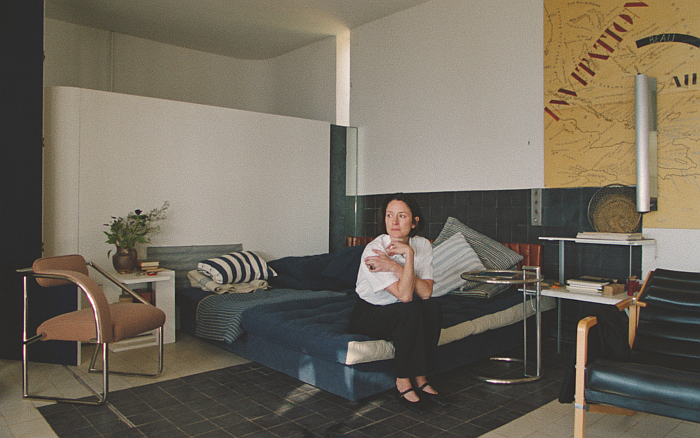
Only one person truly knows, and he died in 1965, swimming in the sea below E.1027. And thus also below Cabanon de vacances, the wooden hut he built just above, overlooking, E.1027. An arguably even more sinister and problematic development than the frescos that is only mentioned en passant in E.1027 but is as worthy of as much investigation as the frescos: Why did Le Corbusier build Cabanon de vacances where he did?
Why did Le Corbusier paint his frescos? And why did he paint what he did, where he did?
Questions E.1027 largely ignores.
E.1027 spends its first 52 minutes carefully building up to the frescos, laying paths to the frescos, and then they are dealt with in 12 minutes; the great many positions and theories surrounding the whys, whats, wherefores, et al reduced to 12 minutes of an 85 minute film.
A brevity of which we approve.
The frescos are by Le Corbusier. The whys, whats, wherefores, et al of the frescos are to be approached in context of Le Corbusier, his character, his biography, are to be approached as tools to help you better understand Le Corbusier, his character, his biography. Something E.1027 not only admonishes you do, but provides and framework in which to. And something we can heartily recommend you do.
But the frescos have nothing to do with what E.1027 wants to be. Have no business there. Are there and must be accepted as being there and be accepted as part of the contemporary E.1027, as part of the E.1027 biography. But aren't part of E.1027
E.1027 is by Eileen Gray, is Eileen Gray. And thus in studying E.1027, in discussing E.1027, in telling the biography of E.1027 the focus must always be Eileen Gray.
Not Le Corbusier.
Which is what Beatrice Minger and Christoph Schaub have produced. A work that started with reflections on the frescos and which uses the paths laid to the significance, symbolism, context and controversy of the frescos, uses an approach to the questions if it is and was a problem that Le Corbusier painted the frescos, and if so what is the problem and why is it a problem, as a conduit to allow one to better approach not the frescos, nor Le Corbusier, but Eileen Gray. Which is a very neat trick. And a very nice refocussing and repositioning of the narrative of E.1027 away from where it has been for so long and towards where it should be. A reclaiming for E.1027 for Eileen Gray.
And while innumerable researchers and academics have, and continue to have, and invariably will continue to have, their say on the frescos, including Minger and Schaub who provide strong clues as to where their consideration have brought them in terms of the frescos, the only views on the frescos that matter, are those of Eileen Gray.
In E.1027 Eileen Gray's character is very upset by them, announcing "This is an act of violence, it's vandalism, un viol", words that are, as best we can ascertain those of her biographer Peter Adam rather than Gray herself12, whereby her character's use of "un viol" rather than the "it was rape" Adam uses poses the question why suddenly throw in a French phrase.
And Eileen Gray?
Towards the end of E.1027 Gray comes to word herself in context of a 1975 audio interview in which she, and without any great emotion, notes that Le Corbusier painted "a good many frescos on the walls" because, "he didn't like plain walls. As a matter of fact I rather like plain walls, still...." she concludes.13
A response that is hard to square with violence, vandalism and viol.
And a response which initially makes it hard to square the Eileen Gray one meets at the end of E.1027 in both the 1975 audio interview and a 1973 television interview, with the Eileen Gray character of E.1027. Even her advanced age, she's in mid her 90s in the early 70s doesn't provide a satisfactory answer. And then you remember her shy, introvert character, a reality that invariably made her more circumspect, reserved, self-effacing in her verbal communication than her non-verbal, a common trait amongst introverts that they are often better with the written word, with constructing, with sculpting, with non-verbal composition and argumentation than they are in direct conversation, that their non-verbal works are more communicative and polemic than their spoken words. And you remember that E.1027 is a hybrid docu-fiction and that much as Eileen Gray's words aren't as spoken, nor are her actions as expressed, rather the Eileen Gray character is a hybrid docu-fiction translation of the non-verbal Eileen Gray, a fictional character based on a documentary research, analysis and questioning; a docu-fiction translation by Minger and Schaub of the Eileen Gray as expressed in her art, architecture and design to a verbal Eileen Gray who, arguably, wouldn't, couldn't, have been so expressive. Which is a nice touch, and one of the more satisfying expressions of the chosen format.
And also a nice tribute to Eileen Gray.
Of which we hope she'd approve.
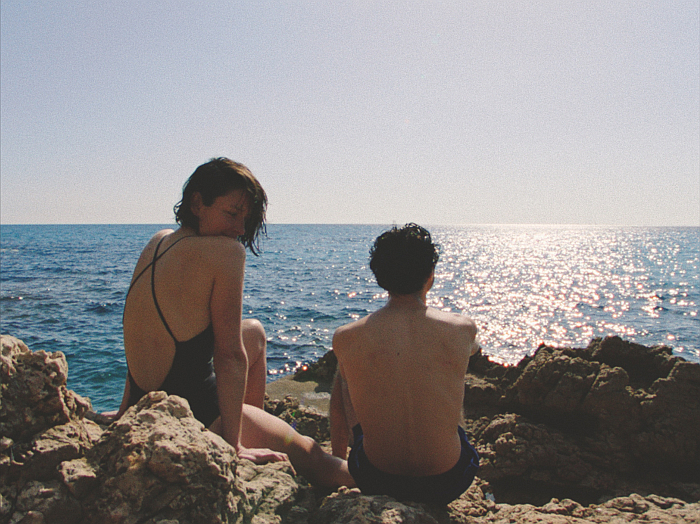
As E.1027 nears its end Eileen Gray's character walks down the path, the more than unfortunately named Chemin Le Corbusier, towards E.1027 "I wanted to be with the house one last time" her character announces... stops short, turns and walks away, "I couldn't do it......."14 she announces, before going on to explain her reasons.
And us all?
Need we be with E.1027?
Certainly not because of the Le Corbusier frescos that were for a great many years the focus of attention when viewing E.1027, as E.1027 neatly argues the focus in context of E.1027 must be Eileen Gray, but need we be with E.1027?
While there is no reason not to visit E.1027, apart from the consequences of over-tourism in the Côte d’Azur, obviously, E.1027 – Eileen Gray and the House by the Sea through the introduction to Eileen Gray it elegantly and effortlessly enables via its discussions on the biography of E.1027, is an admonishment to get to know Eileen Gray beyond E.1027, and also an admonishment to get to know Eileen Gray beyond the few items of her furniture and carpet design that are commercially available today, and to, as E.1027 – Eileen Gray and the House by the Sea does, dive deeper into the whats, whys and wherefores of her work, to question what Eileen Gray was looking for, how she sought to achieve it, the positions she advanced and argued for, the non-verbal arguments she makes with her work, and the forces against which she had to fight, and did fight, despite her shy, introverted manner, to achieve that.
To approach appreciations of the architecture, the world, Eileen Gray envisaged and sought to create, of which E.1027 but was but an early expression, an imperfect expression as she opined, 'only an attempt, a moment in a more general search'15, a search she, regrettably was only able to continue on a theoretical scale, save for a couple of small physical projects such as Tempe a Pailla; but a search she continued, and which if openly and studiously read, and that in a wider context than it is generally read, wider than through the few projects that currently form its narrative, and read in relation to and contrast with the arguments others were advancing at that time, can inform and instruct contemporary discourses on the architecture, on the world, we envisage and the questions of how we realise it.
E.1027 – Eileen Gray and the House by the Sea is an entertaining, well researched, contemplative place to begin that wider reading of Eileen Gray.
E.1027 – Eileen Gray and the House by the Sea by Beatrice Minger and Christoph Schaub is released through Rise and Shine Cinema, and is scheduled to open at cinemas across Germany on October 24th. But we're fairly certain will also be viewable elsewhere. Check local press for details.
The film (in the version we've seen) features spoken French and English with German subtitles.
More information (in German only) can be found at https://riseandshine-cinema.de
1Eveline Schlumberger, Eileen Gray, Connaissance des arts, 258, Août 1973, page 77
2See, for example, Jean-Louis Cohen [Ed.], E-1027 : restoring a house by the sea, Éditions du patrimoine, Centre des monuments nationaux, Paris, 2021 for eyewitness insights into the (hi)story of the villa's decline and recovery.
3Eveline Schlumberger, Eileen Gray, Connaissance des arts, 258, Août 1973, page 77
4Jennifer Goff argues, quite forcibly, that in the 1920s Gray also received help finding her way in architecture from Le Corbusier, that Le Corbusier gave her plans for his projects to study, something not approached in E.1027 but which would help explain Gray's many references to and quoting of Le Corbusier in her arguments and positions against those of Le Corbusier, and also help explain Le Corbsuier's reactions to E.1027, see Jennifer Goff, A Tale of Two Houses: Eileen Gray and Le Corbusier, in Jennifer Goff, Eileen Gray: Her Work and Her World, Irish Academic Press, Sallins, 2015, pages 335 - 371
5Tim Benton, Eileen Gray and Jean Badovici at Vézelay, Journal of Design History, Vol. 36, No. 4, page 340-360
6Jean Badovici, Fenêtre mécanique type paravent, Patent FR691186, published 2 octobre 1930 one of several patents Badovici acquired, the greater many for boats, something alluded to in E.1027
7E.1027: E for Eileen; 10 for Jean; 2 for Badovici; 7 for Gray It is often claimed, indeed is so in E.1027, that E.1027 is an inter-twinning, interlocking, entangling of Eileen Gray and Jean Badovici...... it's not, that would be E.1072. In E.1027 '102' is very much within 'E7', 102 is at the centre of E7, cocooned and bound by E7, which is a completely different association to an inter-twinning, it's a possession, a dependency, a protection.
8For an overview of some of the press coverage of the Boudoir de Monte Carlo see Caroline Constant, Eileen Gray, Phaidon Press, London, 2000, page 51-55
9Jean Badovici, Eileen Gray, L'Architecture vivante, Automne & Hiver, 1924, page 27
10Jean Badovici, L'art d'Eileen Gray, Wendingen, Vol. 6, Nr 6, 1924, page 12
11Eveline Schlumberger, Eileen Gray, Connaissance des arts, 258, Août 1973, page 72
12see, Peter Adam, Eileen Gray. Architect|Designer. A Biography, Thames and Hudson, London, 1987, page 311
13For more insights into Eileen Gray's views on the frescos, and that she was much more affected by them than "as a matter of fact I rather like plain walls" suggests see Jean-Louis Cohen [Ed.], E-1027 : restoring a house by the sea, Éditions du patrimoine, Centre des monuments nationaux, Paris, 2021, in particular the contributions by Andre Hodgkinson and Jean-Paul Rayon who both discussed the subject with Gray
14Please ignore the very obvious contradiction between "Now, I'm going back" at the beginning and "I couldn't do it" at the end, after she has. Commenting on that discrepancy, that continuity problem, is simply rude....
15Description [of E.1027], L'Architecture vivante, Automne & Hiver 1929, page 28 The text is uncredited, was probably a joint effort by Gray and Badovici, but let's assume it was Eileen Gray alone.....